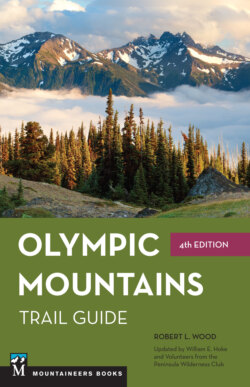Читать книгу Olympic Mountains Trail Guide - Robert Wood - Страница 18
На сайте Литреса книга снята с продажи.
MAMMALS
ОглавлениеAlmost half the territory covered by the Olympic Mountains lies within Olympic National Park, where wildlife is protected, thus making the park one of the nation’s finest refuges because it is large enough to include the annual migratory range of several species. Good habitat is also provided in the adjoining Olympic National Forest and on state lands that border the park on the west.
One is more apt to see wildlife when hiking alone than when traveling with companions. This rule applies to the smaller animals as well as the large mammals.
The Roosevelt elk, native to the Pacific coast, is the largest mammal inhabiting the Olympics, the bulls sometimes weighing as much as one thousand pounds. Wildlife experts estimate that the elk population on the peninsula varies from five thousand to seven thousand animals. How many live within the mountains is debatable, but it is a considerable number. The elk winter in the lowlands, where some herds remain throughout the year, while others (less than 50 percent) move to the higher altitudes during the summer and fall months. Apparently, the elk do not engage in true seasonal migration. Although they are found throughout the Olympics, most of them inhabit the windward side of the mountains.
Elk frequent the rain forests, but they tend to be wary of humans. Elk trails are well defined, and the tracks of the animals are often visible in the mud or snow. Were it not for the elk, the rain forest would be an impenetrable jungle. As the bands wander about, the animals not only graze on grasses and sedges but also browse on the tender shoots, leaves, and twigs of willow, alder, huckleberry, vine maple, and salmonberry—thus creating a landscaped effect. The elk population is determined chiefly by the availability of forage, secondarily by the number of animals that perish during the winter. Predation, particularly by cougars and bears, also has some effect upon their numbers.
Hikers are more likely to see deer. Both the Columbia black-tailed deer and the mule deer are present in the Olympics. The former, the native variety, is the one most often observed. The mule deer was introduced into the area many years ago and is comparatively rare. When deer run, they actually bound, jumping high into the air. Apparently, this is a defense mechanism— they leap high in order to obtain a better view of their surroundings when attempting to elude pursuit.
Mountain goats are not native to the Olympics; they were introduced into the area in the 1920s. Their numbers increased slowly at first, but accelerated greatly during the 1970s and 1980s. This was probably due to several factors: lack of natural enemies, abundant and previously unexploited habitat, and the prohibition on hunting in the national park. They, in fact, became so numerous that in some locations, they have severely damaged the native vegetation, particularly endemic, low-growing plants in the subalpine meadows. In addition, goats have a naturally high affinity for salts and, due to the lack of natural salts in the Olympic range, they learned to seek out human sources such as sweat and urine. This led to goats becoming habituated to people in many areas of the park, with some becoming aggressive and dangerous in their salt-seeking behavior. Because mountain goats are not native, are affecting native plants and ecosystems that did not evolve with them, and have become hazardous to the visiting public, the park is in the process of removing them from the system.
Predators in the Olympics include the black bear, mountain lion, bobcat, and coyote. The Olympic wolf once roamed the mountains, but it is believed to be extinct, having been exterminated by hunters and ranchers. None have been observed since the mid-1920s. Another native predator, the Pacific fisher, was reintroduced to the park in 2008.
There is not an estimate of the number of mountain lions in Olympic National Park. Because the big cats are elusive, they are seldom observed, and sightings have become less common the last few years. This is true also of bobcats and coyotes, which are comparatively rare; black bears, however, are fairly numerous. They are found throughout the Olympics, and almost every hiker has encountered them. The black bear has several color phases, but the black phase is the only one that occurs in the Olympics.
Among the smaller animals, the most common are the Olympic marmot, Douglas squirrel, Townsend’s chipmunk, raccoon, snowshoe rabbit, and mountain beaver. Fur bearers are rare, but include the otter, weasel, fisher, marten, and mink.
Marmots generally inhabit the high meadows, and they seem to be everywhere, whistling continuously whenever their realm is invaded. They often frolic on the snow, playing with one another. Two will stand nose to nose, facing each other, then rise upon their hind legs, appearing to shake hands or touch noses. One cannot but wonder what this maneuver means. Then they drop to all fours, flip their tails, and race away across the snow, only to repeat the performance.
Significant by their absence in the Olympics are several animals native to the Pacific Northwest. When the Cordilleran Ice Sheet overwhelmed the Puget Sound basin during the last ice age, the animals fled south ahead of the advancing ice. When the glaciers retreated, the wildlife gradually returned, but some species are now extinct and others have never made their way back to the peninsula. Still missing are the red fox, wolverine, pika, and golden-mantled ground squirrel.
